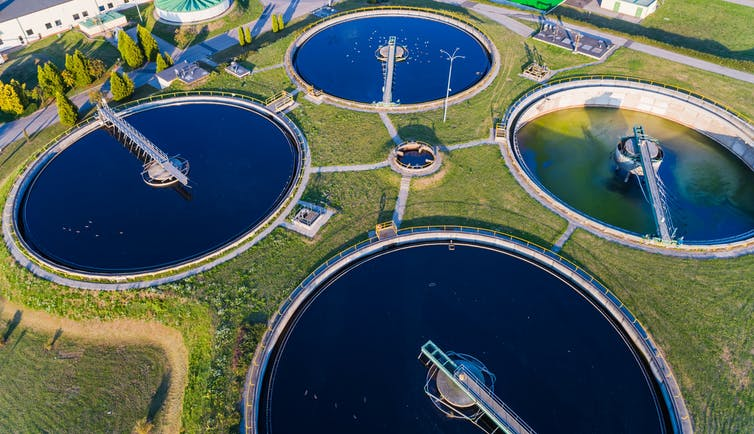Sep 15 2020
A team of researchers from RMIT University has developed a new technology that enables the use of biosolids to generate hydrogen from wastewater.
 The new approach means all the materials needed for hydrogen production could be sourced on-site at a wastewater treatment plant. Image Credit: RMIT University.
The new approach means all the materials needed for hydrogen production could be sourced on-site at a wastewater treatment plant. Image Credit: RMIT University.
This innovative technology supports the complete recycling of sewage—one of man’s limitless resources.
The technology is centered on the advanced upcycling of biogas and biosolids, which are both by-products created during the wastewater treatment process.
This patented technology, developed by the RMIT University team, uses a unique material obtained from biosolids to trigger chemical reactions for generating hydrogen from biogas.
In this method, all the materials required for producing hydrogen can be sourced on-site at a wastewater treatment plant, without having to purchase costly catalysts.
The technique is also capable of capturing the carbon found in biogas and biosolids, which could support a near-zero-emission wastewater sector in the days to come.
Kalpit Shah, the lead researcher and Associate Professor, stated that current commercial approaches for generating hydrogen were emission and cost-intensive, and largely depended on natural gas.
Our alternative technology offers a sustainable, cost-effective, renewable, and efficient approach to hydrogen production.
Kalpit Shah, Lead Researcher and Associate Professor, RMIT University
Shah is also the Deputy Director (Academic) of the ARC Training Centre for Transformation of Australia’s Biosolids Resource at RMIT University.
He added, “To enable the transition to a circular economy, we need technology that enables us to squeeze the full value from resources that would ordinarily go to waste. Our new technology for making hydrogen relies on waste materials that are essentially in unlimited supply. By harnessing the power of biosolids to produce a fully clean fuel from biogas—while simultaneously preventing greenhouse gas emissions—we can deliver a true environmental and economic win.”
In agriculture, biosolids are generally used as fertilizer and soil amendment, but about 30% of the biosolids resource in the world is stockpiled or shifted to a landfill, representing an environmental challenge.
Dr Aravind Surapaneni, Senior Research and Planning Scientist at South East Water and Deputy Director (Industry) of the ARC Training Centre for Transformation of Australia’s Biosolids Resource, stated that research into new and beneficial uses for biosolids was very crucial.
“The wastewater sector is constantly looking to develop new ways to transform biosolids into high-value products, in environmentally sustainable and responsible ways,” added Surapaneni.
How the Technology Works
In the new technique, the biosolids are first converted into biochar—a carbon-rich form of charcoal used to boost soil health. The method has been reported in the International Journal of Hydrogen Energy.
The biosolids-derived biochar is composed of certain heavy metals, which make it a suitable catalyst for creating hydrogen from biogas. As part of the experimental bench-scale research, scientists examined the process with a methane-rich gas that is similar to biogas.
They demonstrated that the biochar produced from biosolids is very effective for transforming the gas into its component elements—that is, carbon and hydrogen.
This decomposition process can also be carried out in a hyper-efficient and uniquely designed reactor, built and patented by RMIT University, which can create hydrogen as well as a high-value biochar coated with carbon nanomaterials.
By transforming the carbon found in biosolids and biogas into advanced carbon nanomaterials, the new technique can also trap and sequester the greenhouse gas to stop its discharge into the atmosphere.
The biochar coated with carbon nanomaterials and created through the novel method has a variety of possible applications, such as boosting agricultural soils, environmental remediation, and energy storage.
Patented Reactor Technology
Shah added that the exclusive reactor built by the RMIT School of Engineering group was pivotal to this groundbreaking recycling method.
We’ve radically optimised heat and mass transfer in our reactor, while shrinking the technology to make it highly mobile. There are no reactors available that can achieve such phenomenal heat and mass integration, in such a small and cost-effective package.
Kalpit Shah, Lead Researcher and Associate Professor, RMIT University
Shah added, “And while it’s already energy efficient, with further integration, this reactor could turn biosolids and biogas conversion into a process that actually produces energy instead of consuming it.”
In addition to being used in wastewater treatment, the new reactor has prospective applications in the plastics, biomass, and coating sectors.
The study was funded by South East Water, which will be trialing the biogas and biosolids conversion technology in a pilot plant that is presently under development.
Dr David Bergmann, Research and Development Manager at South East Water, stated that the technology could possibly be adopted by the industry.
Supporting these kinds of innovative emerging technologies is an important part of our commitment towards reduced emissions and a circular economy approach involving wastewater.
Dr David Bergmann, Research and Development Manager, South East Water
The Australian Research Council Training Centre for Transformation of Australia’s Biosolids Resource based at RMIT University pools together expertise from 20 international and national associates from Australia, the United States, and the United Kingdom, including wastewater sector, universities, and allied industry partners.
Directed by Distinguished Professor Andy Ball, the center explores how to optimally manage this useful resource throughout the whole process—right from treating biosolid waste and transportation, to legislation and enhanced uses to benefit land management and agriculture.
The training center is also supporting the promotion of a well-skilled workforce that will be set to use the novel technologies, as they are deployed.
Journal Reference:
Patel,S., et al. (2020) Production of hydrogen by catalytic methane decomposition using biochar and activated char produced from biosolids pyrolysis. International Journal of Hydrogen Energy. doi.org/10.1016/j.ijhydene.2020.08.036